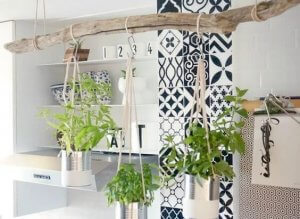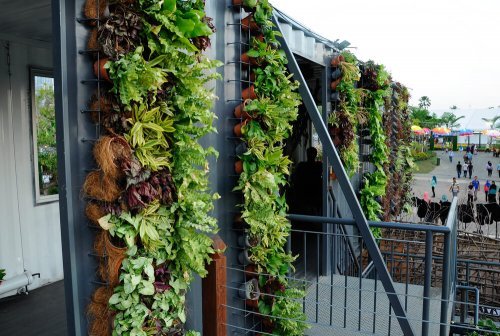4 Tips for Making a Hanging Garden

If you like gardening but don’t have the yard space, a hanging garden is your best solution. A hanging garden takes up minimal space and you can set them up according to your preferences. And you can even make the features yourself easily and economically.
Read our tips in today’s post and learn how to make your own hanging garden. You’ll love how simple it is in addition to how gorgeous it’ll look.
What’s your garden space like?
When we think of a hanging garden, the first thing that our minds jump to is the type of plants we want. But that’s actually the last step of pulling a garden together and will depend on the other factors that we’ll explain below.

- Garden orientation. The way your garden faces plays a crucial role in determining which plants will work best in it. First off, see if the area points to the south or north. Cold and wind affect these directions differently so you’ll have to consider plants that are suited for the setting.
- Garden size. Your plants should be appropriately sized for your garden. If you have a small garden along with a narrow balcony, opt for small plants. Or, if you go with climbing plants, remember to trim them every so often.
- Sun and shade. Make sure you know which areas of your garden receive shade and sunlight. Check during both the morning and in the afternoon.
As you can see, plants are actually the last step of creating a garden. First, you need to check the above factors. Don’t buy your plants last-minute. Taking the time to think things through is the best way to create a healthy hanging garden.
Reuse elements
We love reusing and giving old objects a second life. Going against today’s society, where using and throwing out is second-nature, we want to show you different ways of reusing objects that you’ll probably have at home.

- Plastic bottles. Hang plastic bottles vertically or horizontally and make a small hole in them. Then, fill them with dirt to turn them into a flowerpot. Transparent bottles will create an original garden as they’ll put the roots on display. Another idea you can try is spray paint.
- Cans. Use different kinds of cans as flowerpots. Don’t forget to make a hole in the bottom to drain excess water. For a more beautiful garden, we suggest using cans in different sizes and hanging them at different heights.
Shallow-rooted plants work better
Another aspect to keep in mind is that hanging gardens tend to be on the smaller side. Additionally, the containers tend to be shallower and as a result, not all plants can thrive in hanging gardens.
First things first, you should look for shallow-rooted plants. These plants normally need around 20 cm of earth and some varieties only require 10 cm max. Picking plants that have too deep roots might lead to their poor development and disease.

Set up sacks on your wall
Sacks are one of the most popular ideas for vertical or hanging gardens. Essentially, you fasten small bags onto your wall. They can hold a good amount of weight, allowing you to fill them with earth to use as a flowerpot.
If you like the idea and want to try it for your home, you can opt for conventional sacks or buying specially made ones for hanging gardens. We recommend the latter because these sacks are designed for the specific purpose and are porous to help soil drain correctly.
You can find them in all kinds of sizes and colors. The perfect one for your home is undoubtedly out there.
Always check your garden orientation first and remember that choosing your plants comes last. Once you know what to look for, you can choose the best-suited varieties. Try to use reused materials and sacks to give your garden an intimate decor.
If you like gardening but don’t have the yard space, a hanging garden is your best solution. A hanging garden takes up minimal space and you can set them up according to your preferences. And you can even make the features yourself easily and economically.
Read our tips in today’s post and learn how to make your own hanging garden. You’ll love how simple it is in addition to how gorgeous it’ll look.
What’s your garden space like?
When we think of a hanging garden, the first thing that our minds jump to is the type of plants we want. But that’s actually the last step of pulling a garden together and will depend on the other factors that we’ll explain below.

- Garden orientation. The way your garden faces plays a crucial role in determining which plants will work best in it. First off, see if the area points to the south or north. Cold and wind affect these directions differently so you’ll have to consider plants that are suited for the setting.
- Garden size. Your plants should be appropriately sized for your garden. If you have a small garden along with a narrow balcony, opt for small plants. Or, if you go with climbing plants, remember to trim them every so often.
- Sun and shade. Make sure you know which areas of your garden receive shade and sunlight. Check during both the morning and in the afternoon.
As you can see, plants are actually the last step of creating a garden. First, you need to check the above factors. Don’t buy your plants last-minute. Taking the time to think things through is the best way to create a healthy hanging garden.
Reuse elements
We love reusing and giving old objects a second life. Going against today’s society, where using and throwing out is second-nature, we want to show you different ways of reusing objects that you’ll probably have at home.

- Plastic bottles. Hang plastic bottles vertically or horizontally and make a small hole in them. Then, fill them with dirt to turn them into a flowerpot. Transparent bottles will create an original garden as they’ll put the roots on display. Another idea you can try is spray paint.
- Cans. Use different kinds of cans as flowerpots. Don’t forget to make a hole in the bottom to drain excess water. For a more beautiful garden, we suggest using cans in different sizes and hanging them at different heights.
Shallow-rooted plants work better
Another aspect to keep in mind is that hanging gardens tend to be on the smaller side. Additionally, the containers tend to be shallower and as a result, not all plants can thrive in hanging gardens.
First things first, you should look for shallow-rooted plants. These plants normally need around 20 cm of earth and some varieties only require 10 cm max. Picking plants that have too deep roots might lead to their poor development and disease.

Set up sacks on your wall
Sacks are one of the most popular ideas for vertical or hanging gardens. Essentially, you fasten small bags onto your wall. They can hold a good amount of weight, allowing you to fill them with earth to use as a flowerpot.
If you like the idea and want to try it for your home, you can opt for conventional sacks or buying specially made ones for hanging gardens. We recommend the latter because these sacks are designed for the specific purpose and are porous to help soil drain correctly.
You can find them in all kinds of sizes and colors. The perfect one for your home is undoubtedly out there.
Always check your garden orientation first and remember that choosing your plants comes last. Once you know what to look for, you can choose the best-suited varieties. Try to use reused materials and sacks to give your garden an intimate decor.







